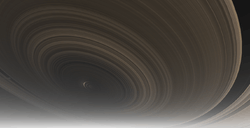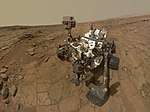PH1b
PH1b (standing for "Planet Hunters 1"), or by its NASA designation Kepler-64b,[4] is an extrasolar planet found in a circumbinary orbit in the quadruple star system Kepler-64. The planet was discovered by two amateur astronomers from the Planet Hunters project of amateur astronomers using data from the Kepler space telescope with assistance of a Yale University team of international astronomers. The discovery was announced on 15 October 2012.[5][6] It is the first known transiting planet in a quadruple star system,[7] first known circumbinary planet in a quadruple star system,[8] and the first planet in a quadruple star system found. It was the first confirmed planet discovered by PlanetHunters.org.[2] An independent and nearly simultaneous detection was also reported from a revision of Kepler space telescope data using a transit detection algorithm.[9]
 Artistic simulation of the quadruple PH1/Kepler-64 star system, as seen from PH1b (foreground). | |
| Discovery | |
|---|---|
| Discovered by | Planet Hunters |
| Discovery site | Kepler space telescope |
| Discovery date | 15 October 2012 [2] |
| Transit [2] | |
| Orbital characteristics | |
| 0.634 ± 0.011 [3] AU | |
| 138.506+0.107 −0.092[3] d | |
| Semi-amplitude | (20.69±0.31)×103[3] |
| Star | Kepler-64 / PH1 [1] |
| Physical characteristics | |
Mean radius | 6.18±0.17[3] R⊕ |
| Mass | 0.08–0.14 [3] MJ (20–50 [3] M⊕) |
| Temperature | 481 K (208 °C; 406 °F) |
Star system
The giant planet is Neptune-sized, about 20-55 Earth-masses (M⊕). It has a radius 6.2 times that of Earth's. The star system is 7200 light years[10] from Earth.[3][11][6][12] The planet orbits a close binary, with a more distant binary orbiting at a distance, forming the quadruple star system. The star system has the Kepler Input Catalogue name KIC 4862625 as well as the designation Kepler-64. The close binary (Aa+Ab) that the planet circles has an orbital period of 20 days. They form an eclipsing binary pair.[1] The two stars are (Aa) 1.384 solar mass (M☉) F-type main-sequence star and (Ab) 0.336 M☉ red dwarf.[13][3][11][7] The planet orbits this binary pair in a 138.3-day orbit. The binary pairs have a separation of 1000 AUs.[1] A photometric-dynamical model was used to model the planetary system of the close binary pair. The distant binary (Ba+Bb) have a pair separation of 60 AU. The two stars are (Ba) 0.99 M☉ G-type main-sequence star and (Bb) 0.51 M☉ red dwarf. The quadruple star system has an estimated age of 2 gigayears.[3] The system is located at right ascension 19h 52m 51.624s declination +39° 57′ 18.36″, so also has a 2MASS catalogue entry of 2MASS 19525162+3957183[14]
Discovery

Kian Jek, from San Francisco, and Robert Gagliano, from Cottonwood, Arizona, spotted the signature of the planet in the Kepler data, and it was reported through the PlanetHunters.org program run by Dr. Chris Lintott, from Oxford University.[6] Kian Jek first spotted a light dip indicative of a transit in May 2011. JKD reported a second. Robert Gagliano performed a systematic search, and confirmed the second dip, and found a third, in February 2012. Using this, Kian predicted another transit, and found it. The planet was subsequently detected by eclipsing binary timing variation method.[1] At the time of discovery, it was the sixth known circumbinary planet.
Role as a benchmark system
The planet PH1b and were used as a benchmark system for automated detection algorithms. As a benchmark system PH1 is used to improve the algorithm and to demonstrate improvement in the detection of circumbinary planets.[15]
See also
- List of extrasolar planet firsts
- PH2 b
References
- PC Magazine, "Citizen Scientists Discover Planet in Quadruple Star System", Tony Hoffman, 16 October 2012 (accessed 20 October 2012)
- PlanetHunters.org, "PH1 : A planet in a four-star system", 15 October 2012 (accessed 20 October 2012)
- arXiv. "Planet Hunters: A Transiting Circumbinary Planet in a Quadruple Star System", Megan E. Schwamb, Jerome A. Orosz, Joshua A. Carter, William F. Welsh, Debra A. Fischer, Guillermo Torres, Andrew W. Howard, Justin R. Crepp, William C. Keel, Chris J. Lintott, Nathan A. Kaib, Dirk Terrell, Robert Gagliano, Kian J. Jek, Michael Parrish, Arfon M. Smith, Stuart Lynn, Robert J. Simpson, Matthew J. Giguere, Kevin Schawinski, 2012 October, arXiv:1210.3612 ; Bibcode: 2012arXiv1210.3612S ;
- "Kepler Mission Manager Update". 2015-04-15.
- Voice of America, "Citizen Astronomers Discover Planet with Four Suns", 16 October 2012
- Yahoo News, "Planet with four suns discovered" Archived 2012-10-18 at the Wayback Machine, Press Association, 15 October 2012 (accessed 20 October 2012)
- SpaceRef, "Planet Hunters: A Transiting Circumbinary Planet in a Quadruple Star System", 14 October 2012 (accessed 20 October 2012)
- NASA JPL, "Citizens Discover Four-Star Planet with NASA's Kepler", Whitney Clavin, 15 October 2012 (accessed 20 October 2012)
- Kostov, V. B.; McCullough, P. R.; Hinse, T. C.; Tsvetanov, Z. I.; Hébrard, G.; Díaz, R. F.; Deleuil, M.; Valenti, J. A. (2013-01-01). "A Gas Giant Circumbinary Planet Transiting the F Star Primary of the Eclipsing Binary Star KIC 4862625 and the Independent Discovery and Characterization of the Two Transiting Planets in the Kepler-47 System". The Astrophysical Journal. 770 (1): 52. arXiv:1210.3850. Bibcode:2013ApJ...770...52K. doi:10.1088/0004-637X/770/1/52. ISSN 0004-637X.
- Gaia Collaboration (2018-08-01). "Gaia Data Release 2 – Summary of the contents and survey properties". Astronomy & Astrophysics. 616: A1. arXiv:1804.09365. Bibcode:2018A&A...616A...1G. doi:10.1051/0004-6361/201833051. ISSN 0004-6361.
- ABC News (Australia), "Astronomers discover planet with four suns", AFP, 17 October 2012 (accessed 20 October 2012)
- KSDK-TV, 'Planet Hunters' discover new planet, PH-1, CNN, 15 October 2012 (accessed 20 October 2012)
- Martin, David V. (September 2019). "The binary mass ratios of circumbinary planet hosts". MNRAS. 488 (3): 3482–3491. arXiv:1904.04832. Bibcode:2019MNRAS.488.3482M. doi:10.1093/mnras/stz959. ISSN 0035-8711.
- Kepler Catalogue, KIC 4862625
- Windemuth, Diana; Agol, Eric; Carter, Josh; Ford, Eric B.; Haghighipour, Nader; Orosz, Jerome A.; Welsh, William F. (November 2019). "An automated method to detect transiting circumbinary planets". MNRAS. 490 (1): 1313–1324. arXiv:1909.07443. Bibcode:2019MNRAS.490.1313W. doi:10.1093/mnras/stz2637. ISSN 0035-8711.
Further reading
- Discovery Announcement: PlanetHunters.org, "PH1 : A planet in a four-star system", 15 October 2012 (accessed 20 October 2012)
- Discovery Paper: arXiv. "Planet Hunters: A Transiting Circumbinary Planet in a Quadruple Star System", Megan E. Schwamb, Jerome A. Orosz, Joshua A. Carter, William F. Welsh, Debra A. Fischer, Guillermo Torres, Andrew W. Howard, Justin R. Crepp, William C. Keel, Chris J. Lintott, Nathan A. Kaib, Dirk Terrell, Robert Gagliano, Kian J. Jek, Michael Parrish, Arfon M. Smith, Stuart Lynn, Robert J. Simpson, Matthew J. Giguere, Kevin Schawinski, 2012 October, arXiv:1210.3612 ; Bibcode: 2012arXiv1210.3612S ;
External links
- NASA JPL, "Citizens Discover Four-Star Planet with NASA's Kepler", Whitney Clavin, 15 October 2012 (accessed 20 October 2012)


